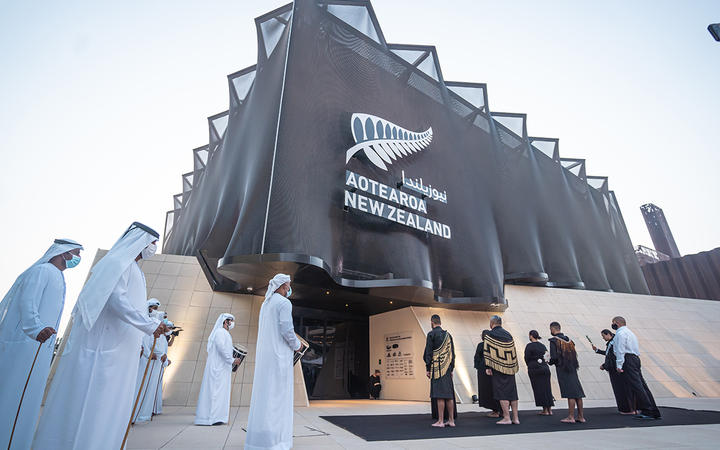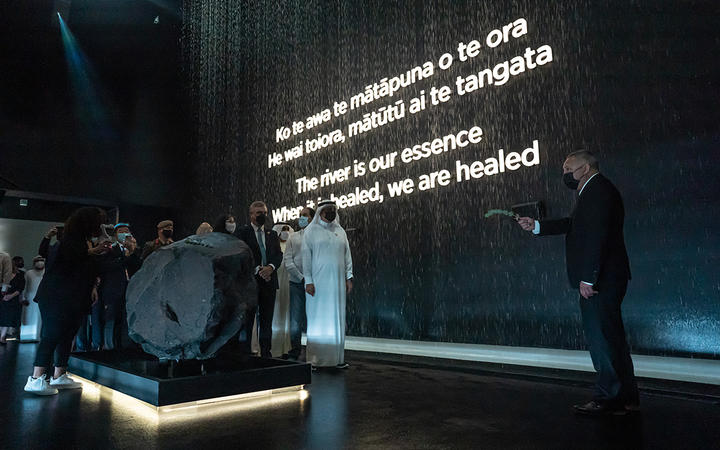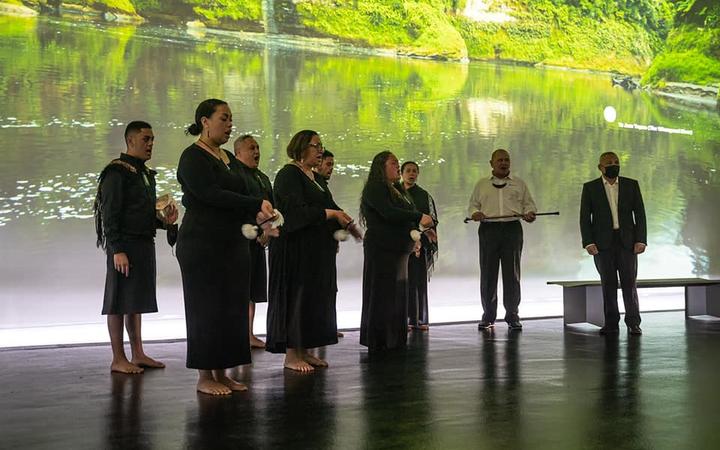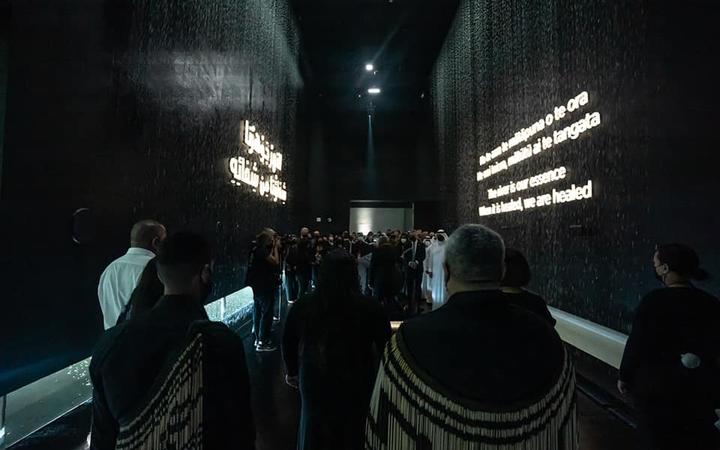Whanganui River iwi leaders have performed a dawn ritual in Dubai to dedicate Aotearoa New Zealand’s immersive pavilion “experience” ahead of the opening of the six-month world trade exposition.

Emirati and Whanganui river leaders perform a dawn ceremony ahead of the opening of Expo 2020 Dubai. Photo: Supplied / NZ at Expo 2020
The small group from the Whanganui River tribes invited Emirati officials to join them for the tāngaengae, a ritual blessing of the experience that has been built around kaitiakitanga and the story of the Whanganui River, Te Awa Tupua, including the river claims and the world-first legal personhood status accorded to the river.
Opening a year late because of the pandemic, the Expo 2020 Dubai experience has been designed in partnership with Te Ātihaunui-a-Pāpārangi/Whanganui River iwi.
The experience aims to deepen understanding of Aotearoa New Zealand and the indigenous environmental ethos of kaitiakitanga, challenging visitors to rethink their relationship with the natural world.
To honour the United Arab Emirates’ role as host of Expo 2020 Dubai, Whanganui river leaders and the New Zealand delegation invited Qasr Al Hosn, an Emirati cultural group to join the dawn dedication ceremony, which began shortly after Fajr prayer. The ceremony began with Emirati traditional performing art Al Ayyala, followed by the tāngaengae ritual performed by members of Whanganui river iwi.

Whanganui iwi leader Gerrard Albert blesses a toka (boulder) from Mount Tongariro, the source of the Whanganui River. Photo: Supplied / NZ at Expo 2020
Speaking to Local Democracy Reporting from Dubai, Whanganui iwi leader Gerrard Albert said the tāngaengae ritual recounts the connection of humankind with the natural world and was accompanied by the beat of poi, intertwined with rituals to give rise to the mauri (life principle) of the pavilion experience.
“Our role is to dedicate the mauri and to uphold the integrity of Te Awa Tupua. That’s why we’re here. The tāngaengae gives rise to the mauri,” Albert said.
“The mauri roused by the tāngaengae will inspirit visitors to the Aotearoa New Zealand pavilion with the same sense of connection to nature as we have. Our sentinel tribal proverb is Ko au te Awa, ko te Awa ko au – I am the River, the River is me. This proverb represents an innate connection with the natural world that we know all people share.”
Albert said that because of the Covid pandemic, a much smaller group than originally planned travelled to Dubai this week to “launch the waka correctly on a straight path”.
“That happened this morning (Thursday), but actually all the work was done at home. We have been working on this for three-and-a-half years.
“Since the [Te Awa Tupua (Whanganui River Claims Settlement) Act] legislation in 2017, Te Awa Tupua has been internationally hot and domestically not. All the attention has actually come from overseas, and we’ve talked to many, many news agencies, people who are interested, research institutes worldwide. We want to ensure the story of Te Awa Tupua is told with integrity.”
Te Pou Tupua, Tūrama Hāwira, who speaks for Te Awa Tupua, helped lead the dawn ceremony, along with Keria Ponga, Naani Waitai, Rāwiri Tinirau and others from the Whanganui River.

Whanganui River iwi members perform the tāngaengae ritual at dawn in the New Zealand Pavilion in Dubai. Photo: Supplied / NZ at Expo 2020
Whanganui iwi are not maintaining a paepae at the six-month exposition, but will travel to Dubai twice more at key times to uphold the mauri of the Awa Tupua experience and the story being told. The first will be in November when the three-day global indigenous forum Te Aratini is held in the New Zealand Pavilion, and tribal leaders will make a final trip in 2022.
Expo 2020 Dubai opens on 1 October until 31 March 2022, with 191 nations participating.
New Zealand Commissioner-General to Expo 2020 Dubai, Clayton Kimpton, said the New Zealand Pavilion was created with a ground-breaking combination of new technology and indigenous culture and storytelling.
“The people of Whanganui have generously allowed us to share their story on behalf of Aotearoa New Zealand. We look forward to sharing this universal story about the need for us to protect and care for people and place for future generations. We believe visitors will leave inspired to find out more about how we can innovate together to solve global challenges.”

A representation of Te Awa Tupua, the Whanganui River, in the New Zealand Pavilion in Dubai. Photo: Supplied / NZ at Expo 2020
Located in the Sustainability District of Expo 2020 Dubai, the New Zealand pavilion exterior has also been designed to show the connection between people and the environment. Its façade moves in time with a low-frequency sound to create a rippling pulse effect, referencing the mauri, or life-force, within the pavilion.
“Mauri is the life principle of the universal order, and we are part of that universal order along with all natural elements. In entering the pavilion, it is as if you are entering your ancestor, entering back into yourself to understand that connection to the mauri we share with nature,” Albert said.
The mauri is centred in a toka (boulder) brought to Dubai from Mount Tongariro, the source of the Whanganui River.
The interior includes a room with water falling from a height of nine metres on either side of the visitor, as a representation of the Whanganui River, Te Awa Tupua. Here, visitors will learn about the Whanganui River legislation and how an indigenous value set has been shared by the Whanganui river tribes and embodied in law.
The 2000 square metre pavilion also features the licensed restaurant Tiaki, showcasing the country’s food, beverage and hospitality, and five-time World Hip Hop dance champion Parris Goebel is curating a six-month entertainment and cultural programme which will include Six60, Kimbra, DJ Sirvere and Sammy Johnson.

Local Democracy Reporting is a public interest news service supported by RNZ, the News Publishers’ Association and NZ On Air.